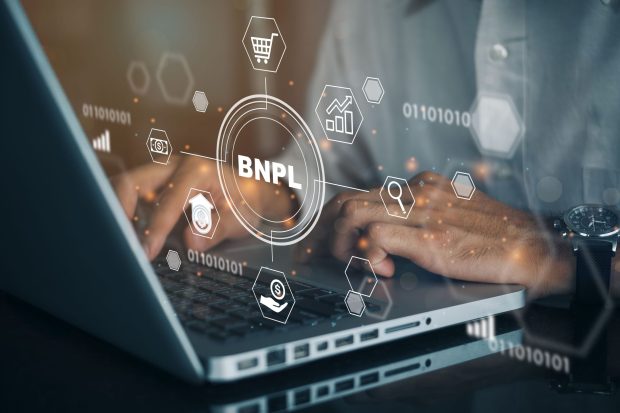PYMNTS Intelligence: Exploring Buy Now, Pay Later’s Popularity and Digital Fraud Prevention Tactics

The growth of digital payments over the past several years has inspired many new alternative payment methods, but few are growing as fast as buy now, pay later (BNPL). These solutions typically allow customers to put zero dollars down at the point of purchase and instead pay over the course of several weeks, either directly to the seller or through a third-party service that collects the payments from customers and pays the merchant.
These solutions are particularly popular among younger shoppers and are threatening to eat into the credit card market. Just 43% of consumers ages 18 to 31, for example, use credit cards, but this group represents the largest portion of the BNPL market. One study found that 60% of BNPL users in Australia are between the ages of 18 and 34, largely because of this demographic’s penchant for shunning traditional payment methods such as credit cards.
BNPL’s popularity, especially among consumer segments such as millennials and Generation Z, is inspiring merchants to integrate the payment method either through in-house programs or by partnering with third-party providers. Like all digital payment methods, however, it runs the risk of digital fraud, to which merchants and providers are devoting immense resources to prevent.
This month, PYMNTS explores why BNPL is so popular among consumers, how fraudsters aim to take advantage of it and how legitimate customers can be protected.
Why Consumers and Merchants Choose BNPL
BNPL’s appeal is fairly easy to pinpoint: Consumers want items immediately but are unwilling or unable to pay the entire cost upfront, prompting them instead to choose to pay in flexible installments. Its precursor is layaway, which saw customers set items aside at the store until they completed their installment payments. BNPL has the added advantage of allowing consumers to obtain the item immediately, rather than having to wait for the entire balance to be paid.
Consumers can leverage BNPL for a wide variety of purchases. Home and furniture goods took the top slot at 42% of purchases, followed by electronics at 30% and apparel at 24%. These rates vary greatly by age, however, with apparel accounting for 40% of purchases among Gen Z BNPL users.
One factor separating BNPL from more traditional loan options is its relatively low value, with 65% of BNPL users leveraging this option for purchases of $500 or less and 32% for purchases of less than $100. Baby boomers and Generation X users had the highest value purchases, with 17% and 11%, respectively, leveraging BNPL for purchases of $3,000 or more.
Merchants are more than happy to provide BNPL options to their customers, as they can drive sales and boost transaction totals. Approximately 33% of BNPL users said they would have not gone through with purchases if financing options were not available, while PayPal noted that average ticket size rose 15% for retailers that offered these financing options.
BNPL may seem like a perfect solution for both merchants and consumers, but some experts warn it is a target for digital fraud. However, a number of solutions exist that can be deployed to mitigate this risk.
BNPL Challenges
Bad actors leverage a wide variety of tactics to defraud BNPL services and their customers, with account takeovers (ATOs) cited as the single most prevalent threat. Fraudsters not only gain access to users’ payment information for use elsewhere, but they also can log on to any eCommerce sites that accept the BNPL provider and make purchases with the victim’s credit.
This is a common technique used for other payment services as well, but it can be especially effective with BNPL because the victim is not billed immediately and may not notice the activity for an extended period of time.
Other fraudsters weaponize chargebacks to scam BNPL firms. These bad actors immediately dispute purchases they made with either their own credit cards or ones they stole from others, attempting to reverse the charges while still keeping the items they purchased — often with the intention of reselling. These methods exploit BNPL providers’ need to make instant credit decisions about their customers, as their propensity for chargebacks leave them with little chance for credit at more established institutions.
Preventing attacks such as chargebacks or ATOs requires diligent user authentication on the part of BNPL providers. These companies must ensure the email accounts applicants provide are legitimate and that their addresses are linked to their actual homes. This task is typically accomplished with some form of multi-factor authentication (MFA).
BNPL providers also can deploy behind-the-scenes pattern analysis to differentiate legitimate customers from potential fraudsters. These systems leverage artificial intelligence (AI) and machine learning (ML) to analyze transaction amounts, types and velocities to pick out unusual transactions that might be the result of fraud. Device data, identity data and behavioral biometrics can augment these systems to develop a holistic view of typical customer spending patterns, and deviations from this baseline could be representative of fraudsters at work.
Despite the risk of fraud, BNPL users still are largely positive about their payments experiences. Most consumers who have leveraged BNPL payments have used them more than once, and 80% said it was easy to use such options at the point of purchase. As long as companies are diligent about protecting legitimate customers, BNPL could remain an attractive alternative payment option for the foreseeable future.

